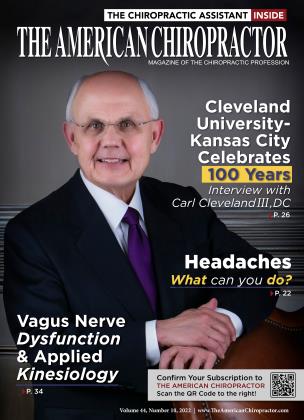In Biology 101 everyone learns that motion is a primary sign of life. This premise is true whether it be the movement of sap in a plant, the pseudopodal movement of a single-celled amoeba, a galloping horse, or a bipedal human.
Optimally functioning people move easily, fluidly, and synchronously. In humans, loss of freedom of movement is clear evidence of complex joint dysfunction.
As chiropractors we evaluate our patients’ movements for alignment, symmetry, and range of motion. Muscle splinting, guarding, and antalgic postures are motion-limiting reactions to joint dysfunction, injury, and pain. Complex joint dysfunction causes the mechanoceptors in the affected area to fire messages to the brain, which reports the nature and severity of the dysfunction. This is called dysafferentation.
These are normal protective reactions to injury, which are employed to give the body time to heal. Ideally, when healing is complete, normal motion is restored. Dysafferentation is replaced by normal afferent nerve flow, which is registered in the brain as “Good to go. Back to normal.”
However, sometimes injuries that appear to be healed continue to cause pain and dysfunction. Dysafferentation that persists after healing is complete is due to a miscommunication between body and brain. Think of this as a roadblock that can cause acute conditions to become chronic. To free up the superhighway of communication so the brain gets the appropriate messaging, we need to reset the mechanoceptors so that normal proprioception is restored. The best way to accomplish this is with chiropractic care.
Historically, chiropractic has been highly successful at getting patients out of pain and moving again. Traditionally, this has been accomplished by single-thrust manual adjustments with the patient lying still on the table. Such techniques, usually referred to as “diversified” and used by 92% of chiropractors, are based on mid-twentieth century technology. Although such static manual adjusting techniques have been successfully used for decades, to achieve optimal correction usually requires multiple patient visits over a period of weeks or even months.
Fortunately, chiropractic is a constantly evolving profession. Twenty-first century research and development has created new technology that uses a class of handheld electronic adjusting instruments that facilitate chiropractors to achieve faster, more reliable, consistent, and lasting results for their patients. No longer limited to static, manual adjusting, these instruments allow us the advantage of new, dynamic adjusting techniques. Handheld percussion instruments allow us to adjust patients in a wide variety of postures and positions; sitting, standing, walking, twisting, turning, in flexion and extension, through the full range of motion. The ability to apply multiple high-velocity thrusts in conjunction with active joint motion is a game changer.
By using dynamic, instrument-assisted adjusting, we are sending movies to the brain instead of snapshots. If a picture is worth a thousand words, how much is a motion picture worth? How much more story does a movie tell? Our brains love the motion picture!
This technology also allows us to use knowledge from recent advances in chiropractic neuroscience. No longer do we have to struggle to move bones. Instead, we reset the mechanoceptors that transmit information to the brain, registering in the sensory cortex, which then relays the information to the motor cortex, which orchestrates the muscular changes necessary to rebalance the body structure.
Dynamic, instrument-assisted adjusting can be used effectively to correct joint dysfunction anywhere in the body. Correction is achieved much more quickly than with static manual adjusting and the results are more long lasting.
Perhaps the most exciting results that can be achieved with this type of adjusting are in the application to the cervical spine.
The discoveries of the neuroscience research project conducted at the New Zealand College of Chiropractic have shown that high-velocity, low-amplitude adjustments in the upper-cervical spine stimulate the mechanoceptors of the small, intervertebral muscles. These have been shown to have a positive effect on the function of the prefrontal cortex of the brain.
The prefrontal cortex isn’t just about pain processing and motor control. It is the executive, emotional, and social part of the brain. It is the seat of our intellectual capacity.
Among the many important functions of the prefrontal cortex are attention, memory, cognitive flexibility, judgment, decision making, planning, self-perception necessary for effective and appropriate behavior in proper context, emotional regulation, stress response, empathy, and overall mental health. And there are many more.
This is huge. It explains much about the chiropractic miracles many of us have seen but could not explain in strict neurological terms.
From above down, inside out, chiropractic affects every function of the mind and body. Dynamic, instrument-assisted adjusting achieves better results quickly, easily, and more completely than ever.
This changes the face of chiropractic.
Dr. William H. Koch is a 1967 Cum Laude graduate of Palmer College of Chiropractic in Davenport, Iowa. He practiced in the Hamptons of Eastern Long Island, New York for 30 years and in the Bahamas for 15 years aboard his motor yacht, The Coastal Chiropractor. He is licensed to practice in New York, Florida and The Bahamas and currently splits his time between Abaco in The Bahamas and his newest practice in Mount Dora, Florida.
Now, wanting to give back to the profession he loves, he offers courses on "The Koch Protocols for Integrated, Advanced, Chiropractic Techniques." Simple, Effective, No Nonsense and Hands On. He may be reached on DrWilliamHKoch.com or by email [email protected].
 View Full Issue
View Full Issue






